<Hippocrates, hippocrates.jpg>
The stethoscope was invented in 1816 when a young French physician named Rene Theophile Hyacinthe Laennec was examining a young female patient. Laennec was embarrassed to place his ear to her chest ( Immediate Auscultation ), which was the method of auscultation used by physicians at that time. He remembered a trick he learned as a child that sound travels through solids and thus he rolled up 24 sheets of paper, placed one end to his ear and the other end to the woman's chest. He was delighted to discover that the sounds were not only conveyed through the paper cone, but they were also loud and clear. The first recorded manuscript documenting auscultation using the stethoscope ( Mediate Auscultation ) was in March 8, 1817, when Laennec noted examining a Marie-Melanie Basset, who was 40 years old. tableofcon.htm
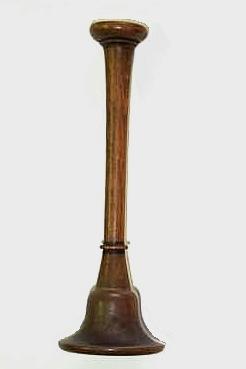
<Early Wooden Stethoscope, stokes_early.jpg>
"I rolled a quire of paper into a kind of cylinder and applied one end to the region of the heart and the other to my ear, and was not a little surprised and pleased to find that I could thereby perceive the action of the heart in a manner much more clearly and distinctly than I had ever been able to do by the immediate application of the ear."
aus_primer_history.html
After great success he would make new models out of wood. Prior to this invention physicians would place their ear to the patient’s chest to hear sounds of the lungs and heart. This type of stethoscope is called a “Monaural” stethoscope due to it having only one earpiece. To make your very own simple working model see the instructions below. Monaural stethoscopes for listening to an unborn baby’s heartbeat are still made today. As time went on many other stethoscopes were developed and made from different materials such as various woods (pine, ebony, cedar), metallic wire tubing, gutta-percha, ivory, metal, India rubber. . .
1829 - Binaural Stethoscopes (two earpiece models) make their debut, but not with much success by a doctor in Dublin.
1860s - The Camman Stethoscope, a binaural model with a bell shaped chest piece is now considered the standard for superior “auscultation” (to listen to sounds in the chest) by American physicians (see illustration above). It would soon be followed by the Ford model.
1890s - A physician & surgeon supply catalog offers stethoscopes from 40 cents for a simple wooden monaural model up to $4.00 for a fancier binaural example.
1898 - The Bowles Stethoscope with its diaphragm chest piece in a flat-iron shape appears. These would be joined by the “combination stethoscopes” in 1902 - having both bell & diaphragm chest pieces for better diagnosis.
1900 - The “Cardiophone” an early electronic instrument to help augment heart sounds arrives on the medical scene. body_stethoscope_history.html

<Camman Stethoscope, stetho1870.jpg>
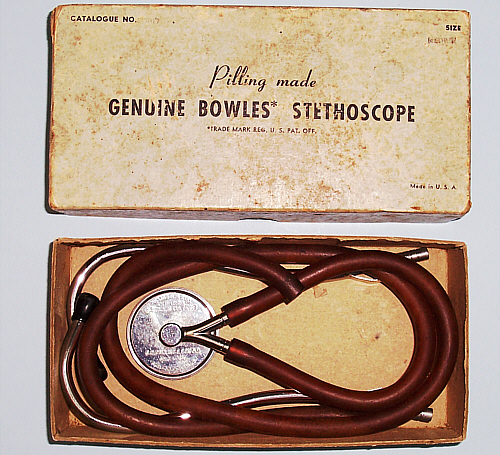
<Bowle’s Stethoscope, bowles_pillingmade-cardbox.jpg>
In the early 1850's there was a rush of designs for a new stethoscope that used both ears. This new "binaural" ('bi-aural') instrument was felt to be the future of auscultation. Actually, the idea for a binaural stethoscope was first introduced in 1829, just ten years after the publication of Laennec's text illustrated his original instrument. The idea belonged to Nicholas Comins, who devised a stethoscope that he described as "a bent tube" that had several hinges, allowing the physician to not have to assume uncomfortable positions during the examination. He offered the suggestion of making his instrument binaural, but there are only sketches of his instrument.
Arthur Leared presented a model of a "double" stethoscope made of gutta-percha at the Great Exhibition in London in 1851 The first commercially marketed model was that of Nathan Marsh of Cincinnati in 1851. His model was made of India rubber and contained the first recorded diaphragm chest piece. However, it proved bulky and cumbersome, and quickly faded. The diaphragm would not re-surface for 50 years. In 1852, Dr. George Cammann of New York produced the first recognized usable binaural stethoscope. He was working as a physician at the Northern Dispensary in New York City and had seen Marsh's model. He also had a model of a soft metal, multiple-tubed stethoscope made by H. Landouzy in 1841, which was designed for two people to listen at the same time. And Charles J. B. Williams claims to have made a binaural stethoscope with lead tubes in 1843. Cammann did not claim to have the original idea for a binaural stethoscope, only to have developed a practical instrument that could be used in clinical practice. Cammann had some help in designing his stethoscope and, interestingly, never patented the stethoscope believing it should be freely available to physicians. The stethoscope was named Cammann's Stethoscope by the manufacturer of the original instrument, George Tiemann. Cammann's model was made with ivory earpieces connected to metal tube that were held together by a simple hinge joint, and tension was applied by way of an elastic band. Attached to these were two tubes covered by wound silk. These converged into a hollow ball designed to amplify the sound, and attached to the ball was a conical shaped, bell chest piece.
tableofcon.htm
Rene-Theophile Hyacinthe Laennec
Born at Quimper, in Brittany, France, 17 February, 1781; died at Kerlouanec, 13 August, 1826, a French physician, discoverer of auscultation, and father of our modern knowledge of pulmonary diseases. He was the son of a lawyer of literary instincts who wrote poems which are said to recall those of his better known compatriot De Forges Maillard. His mother died when he was six, and the boy went to live with his grand-uncle the Abbé Laennec. At the age of twelve he proceeded to Nantes where his uncle, Dr. Laennec, was professing in the faculty of medicine at the university. He was wonderfully successful in his studies and obtained a number of prizes, learned English and German very thoroughly, and began his medical studies under his uncle's direction. At nineteen (1800) he went to Paris and almost within a year obtained there the first prizes in both medicine and surgery at the medical school of the university. He became a pupil of Corvisart, Napoleon's great physician, who had re-introduced into medicine Auenbrugger's neglected method of diagnosis by percussion of the chest. Laennec followed up the idea, so readily suggested by this, of listening to the sounds produced within the chest and, after twelve years of careful study and observation, laid the foundation of the modern knowledge of diseases of the chest.
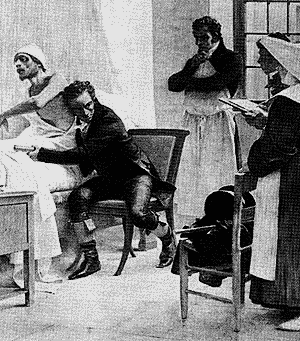
<Laennec, laennec.gif>
He also invented the stethoscope, the original employment of the instrument being suggested by his desire to save a young woman's modesty from the shock of having him listen directly to her chest. Roger sums up what Laennec had thus accomplished when he says that Laennec's ear opened to man a new world in medical science (Roger, "Les Médecins Bretons"). Laennec published his book on the subject in 1819, with the modest motto in Greek "the most important part of an art is to be able to observe properly." Prof.Benjamin Ward Richardson declared (Disciples of Æsculapius) that "the true student of medicine reads Laennec's treatise on mediate auscultation and the use of the stethoscope once in two years at least as long as he is in practice. It ranks with the original work of Vesalius, Harvey, and Hippocrates." Practically nothing of importance has been added to our knowledge of auscultation since Laennec wrote this book. Besides this he made very careful studies in pathology, especially on diseases of the liver. He was the first to study hyatids exhaustively, and it is to him we owe the name cirrhosis of the liver. Alcoholic cirrhosis is often spoken of as Laennec's cirrhosis. He threw much light on sclerotic conditions generally. Unfortunately while studying tuberculosis over assiduously at a time when its contagion was scarcely suspected, he contracted the disease and died at the early age of forty-five.
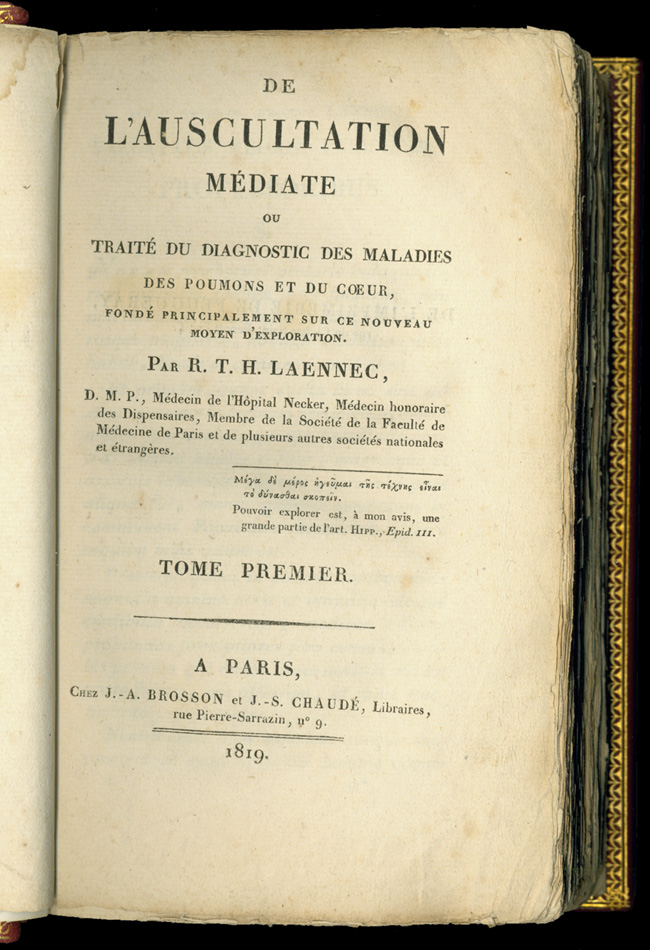
<Early Medical Text by Laennec, RC76_3_L3_1819_title_big.jpg>
Laennec was noted for his kindness and was beloved by his colleagues and his students. He showed himself especially obliging towards his English-speaking pupils. As might be expected from his Breton birth and training, he was intensely religious and was a devout Catholic all his life. A characteristic story illustrates this: On his way to Paris with his wife he was thrown from his carriage. When the vehicle was righted and they had once more been seated he said to her: "Well, we were at the third decade"; then they went on with the rosary they had been reciting just before the accident. His charity to the poor became proverbial and his principal solicitude towards the end of his life was to keep as far as possible from giving trouble to others. Dr. Austin Flint in his lecture on Laennec said: "Laennec's life affords a striking instance among others disproving the vulgar error that the pursuit of science is unfavourable to religious faith." He was one of the greatest clinical students of medicine of the nineteenth century. His principal work is "De l'auscultation médiate", Paris, 1819.
http://www.newadvent.org/cathen/08737b.htm
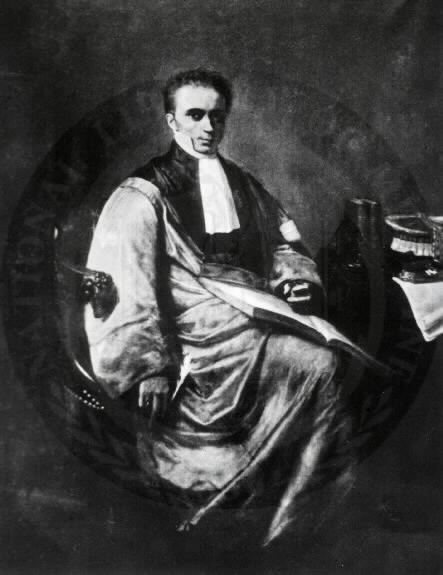
<Laennec2, http://wwwihm.nlm.nih.gov/ihm/images/B/17/138.jpg>
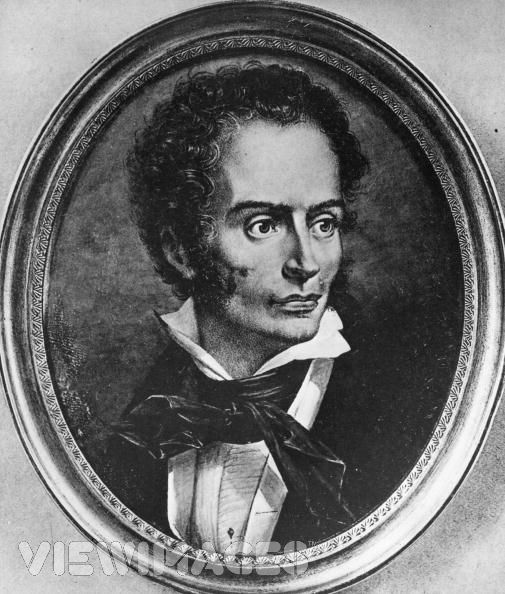
<Laennec3, 8621D6D442D0C97BA55A1E4F32AD3138>
Current practice
The stethoscope is used in aid of diagnosing certain diseases and conditions. The stethoscope is able to transmit certain sounds and exclude others. Before the stethoscope was invented, doctors placed their ear next to the patient's body in hopes of hearing something.
Stethoscopes are often considered as a symbol of the doctor's profession, as doctors are often seen or depicted with a stethoscope hanging around their neck.
Some stethoscopes must be placed directly on the skin, while others can work effectively through clothing. For the stethoscopes with a two-part sound detecting device in the bell, listeners press the rim against the skin, using the bowl-shaped side, to hear low-pitched sounds. The other flat side, called the diaphragm, detects high-pitched sounds.
A stethoscope is used in conjunction with a device to measure blood pressure (sphygmomanometer). The stethoscope detects sounds of blood passing though an artery.
Examination with a stethoscope is noninvasive but very useful. It can assist members of the health care team in localizing problems related to the patient's complaints.
http://www.answers.com/topic/stethoscope?cat=health
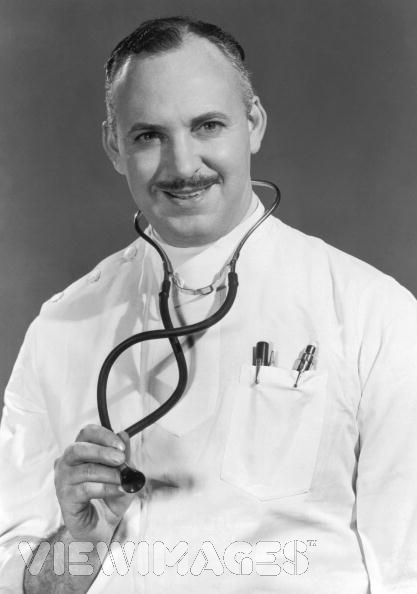
<Doctor with stethoscope, 444ED34A869CB970C117A3F7E5F95793284831B75F48EF45>

<Employing the tool, 22618059.jpg>
Acoustic Stethoscope
Acoustic stethoscopes are familiar to most people, and operate on the transmission of sound from the chestpiece, via air-filled hollow tubes, to the listener's ears. The chestpiece usually consists of two sides that can be placed against the patient for sensing sound — a diaphragm (plastic disc) or bell (hollow cup). If the diaphragm is placed on the patient, body sounds vibrate the diaphragm, creating acoustic pressure waves which travel up the tubing to the listener's ears. If the bell is placed on the patient, the vibrations of the skin directly produce acoustic pressure waves traveling up to the listener's ears. The bell transmits low frequency sounds, while the diaphragm transmits higher frequency sounds. This 2-sided stethoscope was invented by Rappaport and Sprague in the early part of the 20th century. One problem with acoustic stethoscopes was that the sound level is extremely low. This problem was surmounted in 1999 with the invention of the stratified continuous (inner) lumen, and the kinetic acoustic mechanism in 2002. Acoustic stethoscopes are the most commonly used.
http://www.freepatentsonline.com/3109508.html
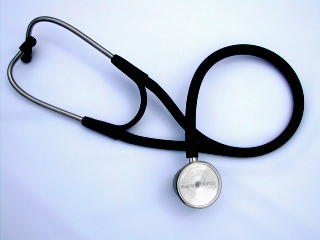
<Acoustic Stethoscope, epicardia.jpg>
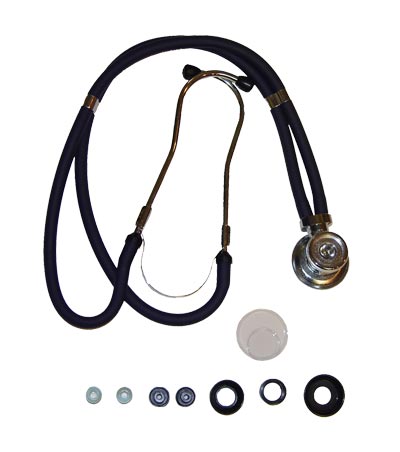
<Another Acoustic Stethoscope, 6426_700.jpg>
Electronic Stethoscope
The next major development in stethoscope design came 100 years later, when the electronic stethoscope appeared in 1980. One application of an electronic stethoscope is the fetal monitor, which is used to listen to a unborn baby's heart rate. With the "external" monitor, the heart rate is heard through belts placed around the mother's abdomen (stomach). With the "internal" monitor, the heart rate is heard through a wire that is attached to the baby's scalp.
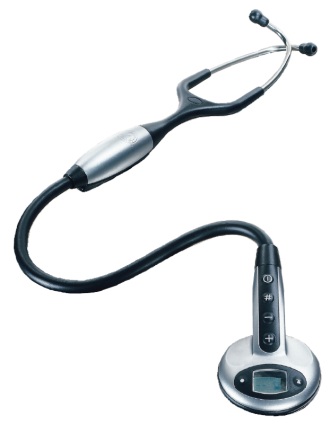
<Electronic Stethoscope, elec4100d.jpg>
The advantage of electronic monitoring of the heart rate is that the monitor provides continuous listening and can pick up uncommon patterns, then can sound an alert so that medical personnel can take immediate action. That action is almost always to deliver the baby by Cesarean section (abdominal surgery), then to guard against oxygen starvation, which may occur with a faulty heartbeat and ultimately result in brain damage.
Electronic stethoscopes are also being studied for their usefulness in areas where the patient is remote (distant) from the physician, a form of diagnosis called telediagnosis. The quality of the information obtained from the electronic stethoscope compared very well with direct, or conventional, auscultation. The method brought the information, or data, to the physician using a modern and a standard telephone line.
When pitted against direct auscultation, the electronic stethoscope missed some faint heart murmurs, so the standard stethoscope-—which doesn't need electricity to work-—remains valuable and widely used. Its portability, low cost, and ready availability make the stethoscope an ideal basic tool.
http://www.discoveriesinmedicine.com/Ra-Thy/Stethoscope.html
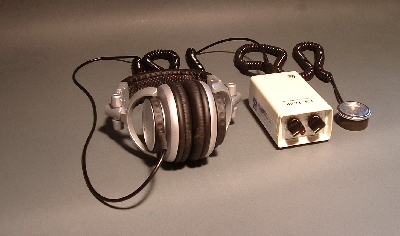
<Early Model, electronic-stethoscope-2.JPG>
An electronic stethoscope (or stethophone) overcomes the low sound levels by electronically amplifying body sounds. However, amplification of stethoscope contact artifacts, and component cutoffs (frequency response thresholds of electronic stethoscope microphones, pre-amps, amps, and speakers) limit electronically amplified stethoscopes' overall utility by amplifying mid-range sounds, while simultaneously attenuating high- and low- frequency range sounds. Currently, a number of companies offer electronic stethoscopes, and it can be expected that within a few years, the electronic stethoscope will have eclipsed acoustic devices.
Electronic stethoscopes require conversion of acoustic sound waves to electrical signals which can then be amplified and processed for optimal listening. Unlike acoustic stethoscopes, which are all based on the same physics, transducers in electronic stethoscopes vary widely. The simplest and least effective method of sound detection is achieved by placing a microphone in the chestpiece. This method suffers from ambient noise interference and has fallen out of favor. Another method, used in Welch-Allyn's Meditron stethoscope, comprises placement of a piezoelectric crystal at the head of a metal shaft, the bottom of the shaft making contact with a diaphragm. 3M also uses a piezo-electric crystal placed within foam behind a thick rubber-like diaphragm. Thinklabs' Rhythm 32 inventor, Clive Smith uses a stethoscope diaphragm with an electrically conductive inner surface to form a capacitive sensor. This diaphragm responds to sound waves identically to a conventional acoustic stethoscope, with changes in an electric field replacing changes in air pressure. This preserves the sound of an acoustic stethoscope with the benefits of amplification.
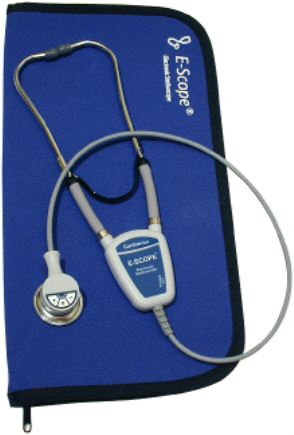
<Modern Electronic Stethoscope, E-Scope_Packbg.jpg>
Because the sounds are transmitted electronically, an electronic stethoscope can be a wireless device, can be a recording device, and can provide noise reduction, signal enhancement, and both visual and audio output. Around 2001, Stethographics introduced PC-based software which enabled a phonocardiograph, graphic representation of cardiologic and pulmonologic sounds to be generated, and interpreted according to related algorithms. All of these features are helpful for purposes of teaching.
http://www.freepatentsonline.com/4598417.html
http://en.wikipedia.org/wiki/Stethoscope
The Next Advancement-Freedomscope
A wireless stethoscopic apparatus is disclosed comprising of an auscultation piece removably secured to a hearing piece. The components, auscultation piece and hearing piece, when not in use can be stored in a carrying case. Housed within the auscultation piece is a conventional radio frequency chip including a microphone that will enable transmission of radio frequency without the use of wires. A transmission system is housed within the auscultation piece, while the hearing piece includes a link manager receiver device for receiving the radio signals wirelessly from the transmission system and enabling sound to be heard via the hearing device from the auscultation piece.
http://freedomscope.com/freedomscope_uspto.htm
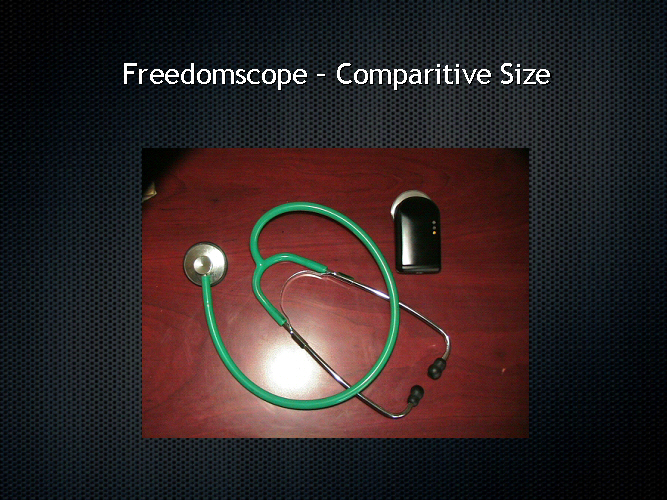
<Freedomscope in comparison to bulkier type, freedomscope_comparative_size.htm >
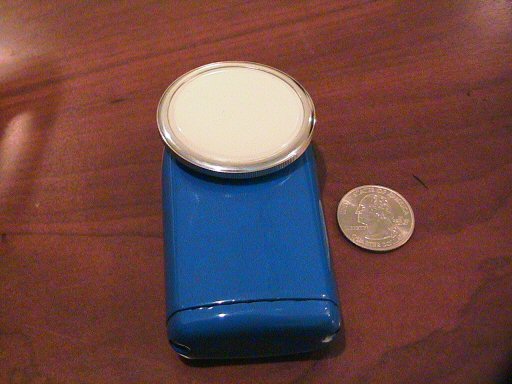
<Freedomscope in comparison to size of quarter, http://freedomscope.com/freedomscope2.htm>
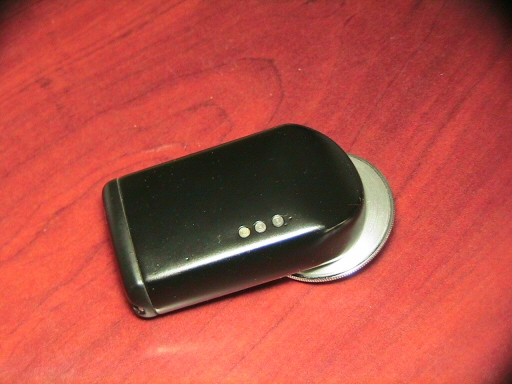
<Freedomscope, http://freedomscope.com/freedomscope3.htm>
Construction/Materials
The first true stethoscopes (based on Laennec 's "baton") were made of wood (usually cedar or pine) tubes that ranged in shape from cylinder- to goblet- or hourglass-shaped. The lengths ranged from 5.90 to 8.86 inches (15 to 22.5 centimeters). Unlike those of today, these stethoscopes were monaural; that is, they were held to one ear and had no ear plugs. This type of stethoscope is still used in some places in Europe. Stethoscopes of varying materials (such as hard rubber or aluminum) were common during the mid-nineteenth century. A few telescoped to provide a stethoscope of varying length. The first innovation was not at first applied to the stethoscope, but to conversation tubes and hearing aids produced by many manufacturers in the late 1800s. These items were at first horn-shaped, yet eventually included earplugs connected to rubber tubes. Designers of stethoscopes adapted such devices, and the stethoscope of the time consisted of an earplug, a flexible rubber tube, and a bell-shaped chestpiece. Despite its short-comings in the conductance of all chest sounds equally, this early stethoscope was commended for its convenient shape and flexibility.
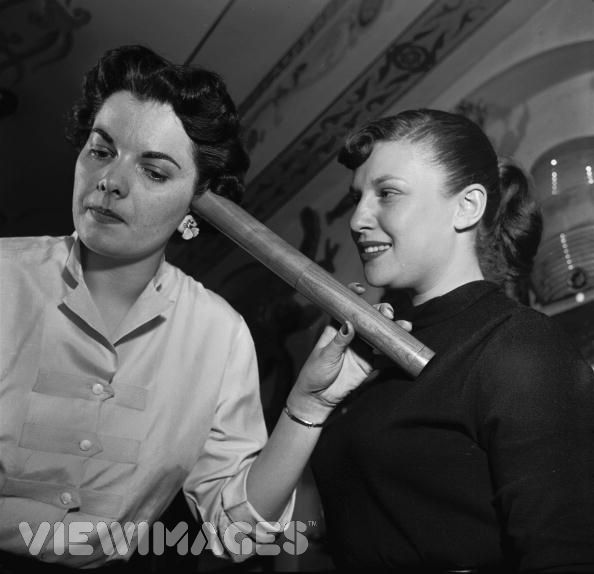
<Primitive Stethoscope, 33237>
Binaural stethoscopes increased in popularity fairly rapidly. As early as 1829 a trumpet-shaped mahogany chestpiece was screwed into a joint from which two lead pipes led to the ears. The device, invented by medical student Nicholas P. Comins, was deemed flexible (despite the rigidity of the wooden and metallic parts), because unlike the earlier monaural stethoscopes, it had movable parts.
The 1840s and 1850s saw the development of prototypes that closely resembled the stethoscope of today. In 1841 Marc-Hector Landouzy of Paris introduced a stethoscope made partly of gum elastic tubes; this proto-type was improved slightly in 1851 by Arthur Leared of Dublin. The main problem with many early designs was the inferior earpieces that provided muffled sound. George Cammann of New York perfected the nineteenth century stethoscope in 1852. His instrument, considered to be the best of the time, had ivory or ebony knobs as earpieces, and these had springs attached to hold them more securely in the ear. The tubes were made of coils of wires sandwiched between rubber that was then coated with silk or cotton. The chestpiece was surrounded by a ring of rubber, creating a suction cup that more easily adhered to the skin.
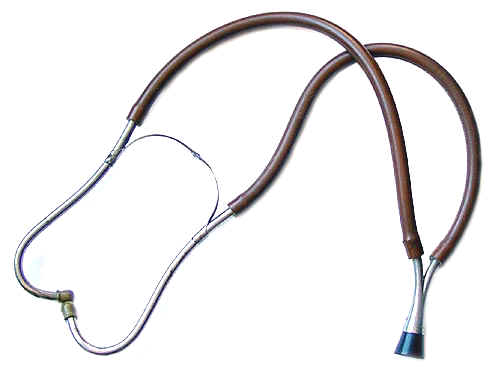
<Stethoscope from 1900, stethoscope_binaural_Fannin.jpg>
Another type of stethoscope was developed in 1859. Designed by Scott Alison, the differential stethoscope had two separate chestpieces, allowing the user to hear and compare sounds in two different places. This stethoscope also allowed the physician to better pinpoint the source of the sound through the natural process of triangulation our ears normally use to discover the direction of sounds.
The first electronic stethoscopes became available as early as the 1890s; by 1902, Albert Abrams developed a truly useable one. With it, he was able to amplify the sounds made by the heart. By applying resistance gradually to the circuit, he could eliminate certain sounds, thereby differentiating between the heart's muscular and valvular movements.
The basic form of the binaural stethoscope has remained virtually unchanged since the beginning of the twentieth century. Major advancements have been made in the type of materials used—plastics such as polyvinyl chloride and Bakelite became available; the manufacturing processes that increase the airtightness and flexibility of the stethoscope have been refined; and large scale production has been streamlined, ensuring that medical practitioners can obtain sufficient stethoscopes from a wide range of choices, and that consumers can purchase stethoscopes for home use.

<The old and the new, medicine,0.jpg>
Raw Materials
A binaural stethoscope consists of earplugs, binaural pieces, flexible tubing, a stem, and a chestpiece. The earplugs are attached to springs made of steel so that they fit firmly in the ears, while the earplugs themselves are made from either Delrin (a trademark plastic that is white, rigid, and similar to nylon) or softer molded silicone rubber. The binaural pieces that run from the earplugs to the flexible tubing, the stem that runs from the flexible tubing to the chestpiece, and the chestpiece itself are made from metal (aluminum, chrome-plated brass, or stainless steel). The flexible tubing is either polyvinyl chloride or latex rubber. The stem for stethoscopes with dual diaphragms has a valve with a steel ball bearing and a steel spring inside. This type of stethoscope can switch from a flat diaphragm to a cupped one when turned by shifting the ball bearing to cover up the pathway to the diaphragm that is not in use. The flat diaphragm is formed from a flat, thin, rigid plastic disk that can be Bakelite, an epoxy-fiberglass compound, or other suitable plastic. Today, most stethoscopes have an anti-chill ring attached to both sides of the diaphragm. The anti-chill ring, besides being more comfortable for the patient, allows better suction and thus allows sounds to be heard more clearly. The rings are made from either silicone rubber or polyvinyl chloride.

<Collecting Rubber, http://rubbercal.com/files/Rubber_Tree_30_.jpg>

<Creating Steel, http://www.rhi-property=Data.jpg>
The Manufacturing Process
Although the stethoscope is a simple device, it is typical for its metal parts and plastic parts to be manufactured at separate locations, and for the entire device to be assembled at yet another location. It is also common for inexpensive models to be sold disassembled. Stethoscopes are rarely custom-made. If there is a large volume sold to one customer, the manufacturer can make a certain specified color or put the name of the hospital onto the stethoscopes.
Making the metal chestpiece
Aluminum is typically die cast. In this process, pressured molten aluminum is injected into molds, forming a slug in the form of a crude binaural piece or chestpiece. The slug is then machined to form its proper shape. Stainless steel arrives in huge rods that are machined on lathes using a semiautomatic process. Brass is also machined before being sent out for electroplating.
The machining process consists of cutting excess metal from the slug or rod according to a plan that will yield a correctly shaped binaural piece or chestpiece. The binaural piece is then threaded at the top for the earplugs, and barbs are cut into the bottom to allow for the tubing connection. The chestpiece is also barbed at the top to allow for the connection. The metal springs are then connected and sealed to the binaural pieces.
<Metal Chestpiece,
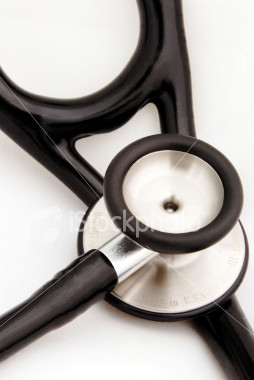
istockphoto_2044036_stethoscope.jpg>
Forming the tubes
More expensive stethoscopes have tubing that is "dipped." The binaural pieces are repeatedly dipped into a liquid latex until the tubes are of the correct thickness. Tubes intended for inexpensive or disassembled models are molded or extruded using standard methods. To attach the separate tubing, it is first heated by placing it in warm water; next, it is pushed onto the binaural pieces, wrapping snugly around the barbs. Another less-common method of attaching the tubing is to place the binaural pieces in a mold and then place the tubing around them to form a seal.
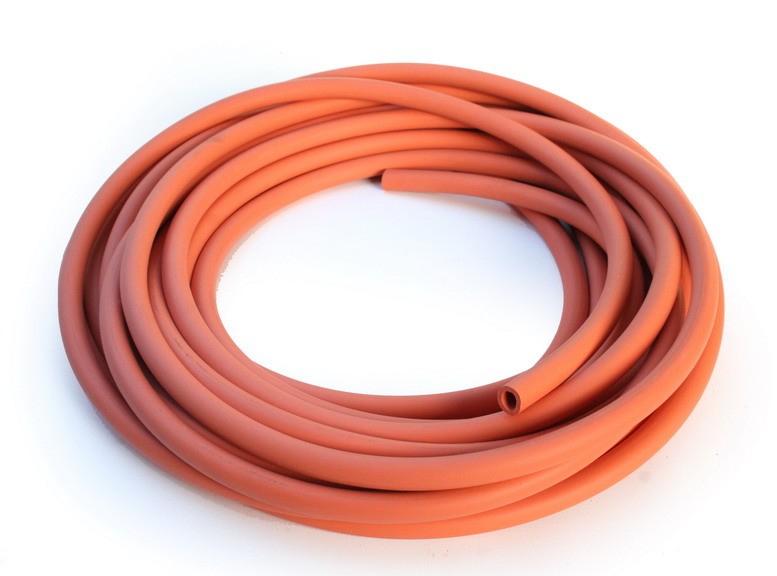
<Rubber Tubing, rubber_tube1.jpg>
Assembly
Stethoscopes are hand assembled. Once the binaural pieces have tubes, the diaphragm is placed in the chestpiece and sealed. Next, the anti-chill ring is put on both sides of the chestpiece. This can be done by cutting a recess in a circular track around the rim and slipping the ring inside. The preferred method is to stretch the ring around the rim of the diaphragm or bell, making a secure fit. The earplugs are then screwed on.
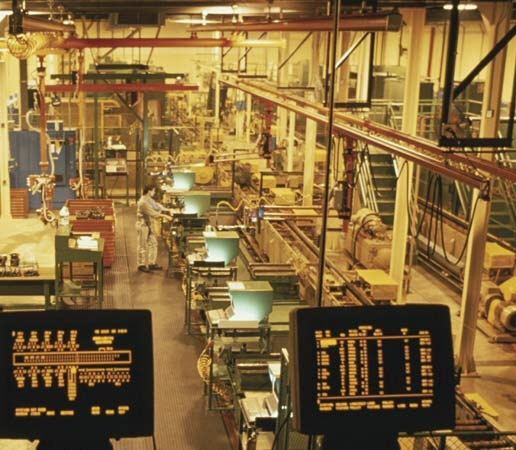
<Efficient Assembly Line, assembly-line.jpg>
Packaging
Inexpensive stethoscopes, which may be disassembled, are placed in bags and sealed. Mid-range stethoscopes are boxed. Quality stethoscopes are placed in sturdy boxes that have spaces die-cut in the packaging into which the stethoscope and accessories fit snugly. The stethoscopes are then placed in cases that hold 20 to 50 boxes each and shipped to medical supply dealers, or, if there is a large volume, directly to a hospital. The medical supply dealers then provide stethoscopes to private practice, hospitals, medical supply stores, and drug stores.
http://www.answers.com/topic/stethoscope?cat=health |



